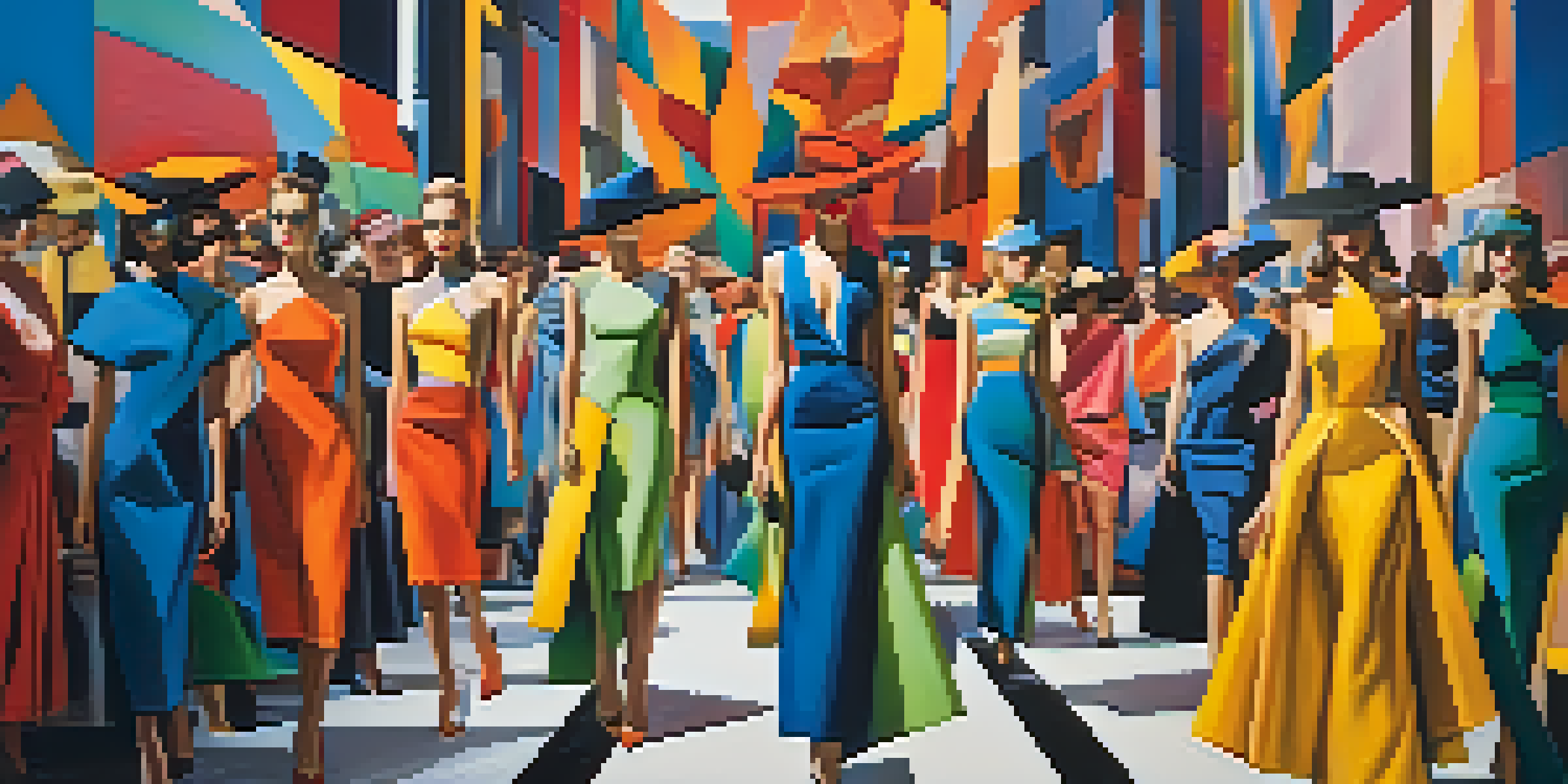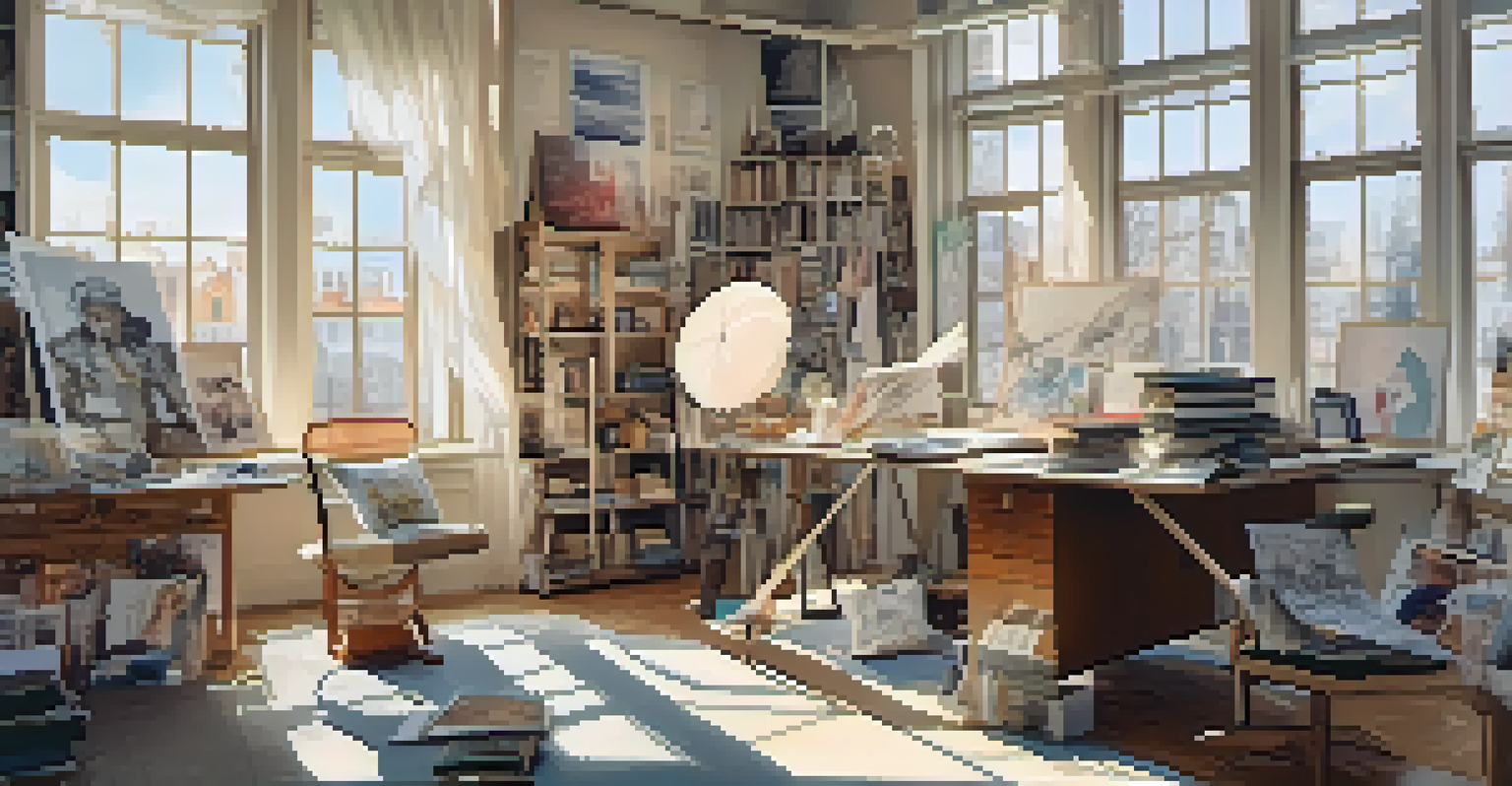Artistic Inspirations Behind Iconic Fashion Designers

The Role of Art Movements in Fashion Design
Art movements have a profound impact on fashion design, often inspiring trends and aesthetics. For instance, the bold colors and geometric shapes of the Cubist movement can be seen in collections by designers like Yves Saint Laurent. This intersection of art and fashion showcases how visual arts can influence fabric patterns and silhouettes, creating a harmonious blend.
Fashion is the armor to survive the reality of everyday life.
Moreover, the Surrealist movement has led designers such as Elsa Schiaparelli to incorporate whimsical elements into their work. By embracing the unexpected, these designers challenge traditional notions of beauty and functionality in clothing. As a result, fashion becomes a canvas where artistic expression thrives.
Ultimately, understanding these art movements allows us to appreciate the depth of inspiration behind iconic fashion pieces. It highlights the designer's role not just as a creator of garments, but as an interpreter of cultural and artistic dialogues.
Nature as a Muse for Fashion Innovators
Nature has always been a significant source of inspiration for many fashion designers. From the intricate patterns of leaves to the vibrant colors of flowers, the natural world offers endless possibilities for creativity. Designers like Alexander McQueen often draw on the beauty and complexity of nature, translating it into stunning garments that reflect the environment's raw elegance.

Additionally, the concept of biomimicry in fashion, where designs mimic natural forms and processes, is gaining traction. This approach not only inspires aesthetic choices but also promotes sustainability, encouraging designers to create eco-friendly pieces. As nature continues to inspire, the fashion industry evolves to embrace both beauty and responsibility.
Art Movements Shape Fashion Design
Art movements significantly inspire fashion trends and aesthetics, allowing designers to merge visual arts with clothing.
By looking to nature, designers create pieces that resonate on a deeper level, connecting wearers to the world around them. This not only enhances the artistic value of the clothing but also fosters a greater appreciation for the environment.
Cultural Heritage and Its Influence on Fashion
Cultural heritage plays a crucial role in shaping fashion, as designers often incorporate traditional elements into their work. For instance, Indian designer Manish Arora is known for blending vibrant traditional textiles with modern silhouettes, creating a unique fusion that celebrates his roots. This ability to honor cultural heritage while innovating is key to the evolution of fashion.
Art is not a thing; it is a way.
Moreover, the globalized nature of fashion today allows for cross-cultural exchanges that enrich design aesthetics. Designers draw from various cultures, resulting in collections that are not only visually stunning but also tell stories of diversity and inclusion. This blending of influences highlights the interconnectedness of the global fashion landscape.
As a result, we see a growing appreciation for cultural narratives within fashion, encouraging a more inclusive approach to design. By celebrating cultural heritage, designers not only create beautiful pieces but also foster a greater understanding and respect for different traditions.
The Influence of Music on Fashion Trends
Music and fashion have long been intertwined, with genres influencing styles and trends. The punk movement, for example, brought about a raw, edgy aesthetic that was characterized by ripped clothing and bold accessories, heavily influenced by bands like The Ramones and Sex Pistols. Designers such as Vivienne Westwood capitalized on this energy, creating pieces that embodied the spirit of rebellion.
Moreover, the rise of hip-hop culture has transformed fashion, introducing streetwear as a dominant style. Artists like Kanye West and Pharrell Williams have blurred the lines between music and design, launching their own fashion lines that reflect their musical identities. This synergy showcases the powerful impact of music on shaping fashion narratives.
Nature Inspires Sustainable Fashion
The beauty of nature serves as a muse for designers, promoting creativity and sustainability in eco-friendly fashion.
Ultimately, music serves as a cultural backdrop that informs and inspires designers. By tapping into the emotions and themes present in music, fashion can evolve to resonate with audiences on a personal level.
Historical Events and Their Fashion Impact
Historical events have always left a mark on fashion, shaping styles in response to societal changes. For instance, the aftermath of World War II saw a return to femininity with Christian Dior's 'New Look,' characterized by cinched waists and voluminous skirts, symbolizing hope and renewal. This shift in fashion echoed the broader desire for stability and normalcy during a turbulent time.
Similarly, the Civil Rights Movement influenced fashion by promoting self-expression and individuality. Designers began to create pieces that celebrated cultural pride, leading to the emergence of styles like Afrocentric fashion. This evolution not only reflected social progress but also empowered individuals to embrace their identities.
As we look back, it becomes evident that fashion is a living history, continuously evolving in response to the world around us. By understanding this relationship, we gain insight into how designers use their craft to comment on and shape societal narratives.
Literature's Impact on Fashion Designers
Literature has always been a rich source of inspiration for fashion designers, often serving as a backdrop for creativity. Classic novels have inspired collections that encapsulate the essence of characters or settings. For instance, designers like Gucci have drawn upon the works of authors such as Virginia Woolf, creating garments that evoke the spirit of literary characters.
Additionally, poetry and prose can influence the color palettes and textures that designers choose. A collection inspired by Romantic poetry might feature soft fabrics and pastel colors, capturing the emotion and beauty of the written word. This fusion of literature and fashion creates a narrative that resonates with audiences on multiple levels.
Personal Stories Drive Fashion Creativity
Designers often channel their personal experiences into their work, creating authentic collections that resonate with audiences.
By exploring the connections between literature and fashion, we see how storytelling transcends mediums. Designers become storytellers themselves, using fabric and form to communicate themes and emotions that echo the literary works that inspired them.
The Role of Technology in Fashion Inspiration
In today's digital age, technology has transformed how designers find inspiration. Social media platforms, like Instagram and Pinterest, allow designers to discover trends and ideas from around the globe in an instant. This access to diverse influences encourages a more eclectic and innovative approach to fashion design.
Moreover, advancements in technology, such as 3D printing and virtual reality, open new avenues for creativity. Designers can now experiment with shapes and materials that were once unimaginable, pushing the boundaries of traditional fashion. This technological evolution not only impacts design but also how fashion is presented and consumed.

As we navigate this tech-driven landscape, it's clear that technology is reshaping the inspiration process for designers. By embracing these tools, they can create unique pieces that reflect contemporary culture while also paving the way for the future of fashion.
The Interplay of Personal Experiences and Fashion
Personal experiences often serve as a wellspring of inspiration for designers, shaping their creative visions. Many designers draw from their own life stories, infusing their collections with emotion and authenticity. For example, Stella McCartney’s commitment to sustainability is deeply rooted in her upbringing, where she was taught to respect the environment.
Additionally, personal challenges and triumphs can influence design choices, resulting in collections that resonate with a broader audience. When designers share their narratives through fashion, it creates a deeper connection with consumers who may relate to similar experiences. This authenticity makes fashion more than just clothing; it becomes a form of self-expression.
Ultimately, the interplay of personal experiences and fashion highlights the human aspect of design. By understanding the stories behind collections, we gain insight into the motivations that drive creativity, making us appreciate fashion on a more intimate level.